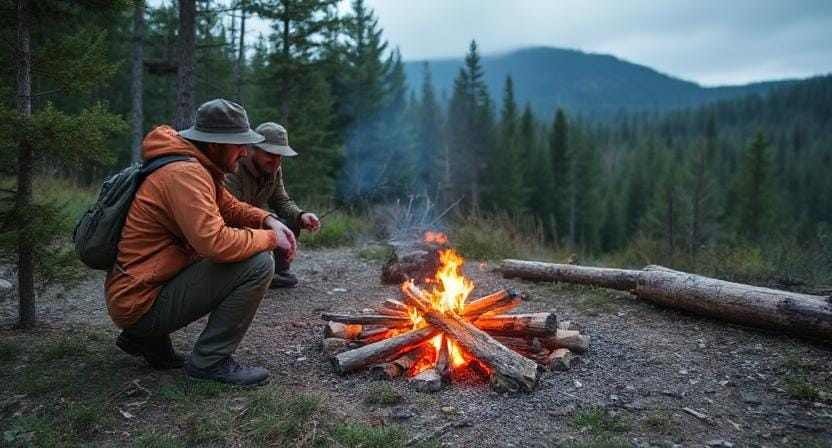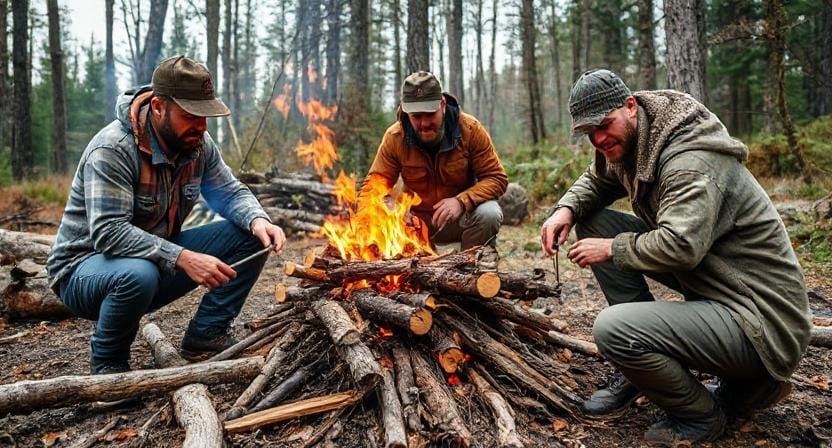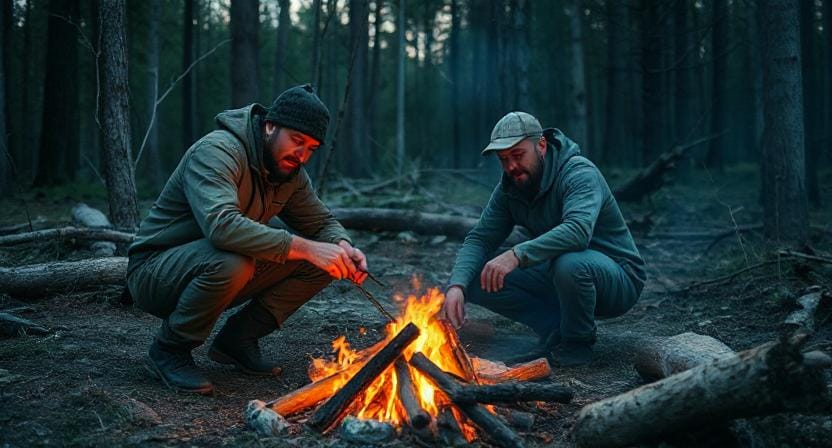Please Note: This post may contain affiliate links. If you click one of them, we may receive a commission at no extra cost to you. As an Amazon Associate, I earn from qualifying purchases.
Top Takeaways and Key Concepts
- Choose a safe fire location away from tents, trees, and wind direction to prevent hazards.
- Gather dry tinder, kindling, and fuel logs to build a successful and long-lasting fire.
- Build a fire structure with airflow using a teepee or log cabin layout for steady flames.
- Light the fire safely using matches or a lighter and avoid dangerous accelerants like gasoline.
- Extinguish the fire completely using water or dirt to prevent leftover embers from reigniting.
Summary of This Article
This article explains how to build a safe and effective campfire step by step. It covers choosing the right location, collecting proper firewood materials, and building classic fire structures like the teepee or log cabin for airflow. The article also emphasizes safe lighting methods and responsible fire maintenance, including keeping water nearby and fully extinguishing the fire to protect nature. With a careful approach, anyone can enjoy a warm, safe, and memorable campfire outdoors.
Short Video Version of this Article
The campfire. It really is something special, isn’t it? A nice place to hang around, toast marshmallows, and tell amusing stories. Like the time I fought a raccoon for my food. Yes, pretty brave, right?
It feels so beautiful to sit around a fire beneath the stars. But starting the fire? A completely new adventure. It’s not always easy to locate a nice movie to watch.

You need to have the correct things. Some dry wood, twigs, and maybe some leaves. It’s like getting all of your favorite toys ready to play with. And getting it to catch? That’s an art! You want that first spark to move.
It needs love once it’s up and running. A little blowing here and there. It’s like a puppy that wants some love. It will keep you warm and cozy as long as you give it wood.
So get your stuff and get ready. Let’s make a fire that Smokey Bear would be proud of! Just keep an eye on those marshmallows. You know how easy it is to burn them? They’re gooey and sloppy, but they’re so good! 🍫🔥✨
Choosing Your Location Wisely

First things first: location, location, location! You wouldn’t build a house on quicksand—so why would you set up your campfire anywhere less than ideal? Look for flat ground at least 10 feet away from tents, trees, and anything else that might go “whoosh” when flames get too close.
You know, wind direction really does matter when you’re camping. If you’re with friends who have, um, less-than-stellar aim while roasting hot dogs—trust me, I’ve seen it—set up your fire so the smoke doesn’t blow right into their faces.
Picture this: everyone’s sitting there, trying to enjoy their food, and then someone’s waving their arms like they’re conducting an orchestra. “I’m trying to eat here!” they shout. It can ruin the fun pretty fast.
Then there’s the rules about fires. Always check them first. Some places have strict rules about where you can build a fire. Nobody wants to turn their campsite into a wild bonfire party when they just wanted a cozy night.
It’s all about safety and making sure everyone has a good time. Plus, a little planning makes those hot dogs taste even better. So, keep an eye on that wind and check the rules. A smooth camping trip is the best camping trip!
Gathering Firewood Like a Pro

Now comes the fun part: gathering wood for the fire! You can be a lumberjack here without needing chainsaws or flannel clothing. To begin, look for three kinds of wood: tinder (like dry leaves or small twigs), kindling (like little sticks), and fuel logs (the big ones).
You might believe that merely throwing some random sticks together will work. No, not really. It’s like trying to get your friend to sing karaoke if your tinder doesn’t catch fire easily. Good luck with that!
Getting wood is a bit of an art. Instead of breaking branches off of living trees, look for dried sticks on the ground. You really don’t want to mess with Mother Nature. You know how that one relative pops up uninvited and is always grumpy?
Only take what you need. A little respect may go a long way. Pick up some smaller branches and twigs, but only the ones that have already fallen. It will help the forest stay healthy and happy.
A good fire needs good wood and some planning, so keep that in mind. It’s all part of the romance of camping, and it makes everything seem like an adventure. So, while we burn those marshmallows, let’s be nice to nature. Does that sound good?
Building Your Fire Structure

Once you’ve gathered enough wood to satisfy even the most ambitious camper’s dreams of grandeur, it’s time to build your fire structure. There are several classic styles out there—the teepee is popular because it looks cool and is easy to assemble. Just arrange some kindling in a cone shape over your tinder pile.
Honestly? I’ve had my ups and downs with building a fire. Sometimes it looks more like a messy pile than a cozy campfire. Ever see a fire structure collapse? It’s like watching a tower of blocks go splat!
If you’re feeling fancy, try the log cabin style. Stack those bigger logs parallel, then add smaller ones on top like you’re making little furniture for forest animals. It’s cute, right?
No matter which method you pick—or maybe you just throw things together like a fun puzzle—make sure there’s space for airflow. Air helps the flames dance and thrive.
Picture this: you finally build your fire, and it looks great. Then, poof! It flops down like a pancake. Total camping fail. That’s not the memory you want to take home.
So, keep the air flowing and don’t stress too much. Even if it’s a bit chaotic, you’ll still enjoy those glowing flames and warm marshmallows. Let’s just try to avoid pancake moments, okay?
Lighting It Up Without Burning Down the Forest

Now we reach perhaps the most exciting moment—the lighting! Use matches or a lighter (and no, not one from last week’s birthday party) to ignite your tinder while holding your breath in anticipation like you’re waiting for Christmas morning.
If everything goes just right—and by “right,” I mean maybe a little chaos—you’ll see those tiny flames start to flicker and dance around the kindling. It’s magical, really! Just don’t start waving your arms like you’re calling for help. Gentle breaths work way better.
Need a boost? Just a soft puff on the flames can help them grow. No need for drama here.
And oh boy, let’s talk about fire starters. If your flames don’t cooperate, don’t even think about using gasoline or lighter fluid. Trust me, that’s a recipe for trouble. Picture this: you’re at a family barbecue and the stories come out about “that one time.” Everyone’s laughing, but not the good kind of laughter.
Keeping it safe is way more fun. Building a nice campfire makes for stories worth sharing. Let’s stick to the gentle stuff, okay? Enjoy the warmth, and let those flames grow slowly. It’s way more satisfying that way.
Maintaining Your Campfire Like a Seasoned Pro

Congratulations! You’ve successfully built your campfire—but now comes maintenance because fires don’t just sit there looking pretty; they require care too! Keep adding fuel logs gradually as needed but avoid smothering it under heaps of wood—you want cozy warmth rather than smoke-filled chaos!
Keeping water nearby is also essential—not just for putting out rogue flames but also for cooking delicious meals over said fire! Trust me; nothing tastes better than beans cooked right over glowing embers after hiking all day—even if they were from a can!
As the sun sets and the stars come out, it feels magical. Those little twinkling lights are like a disco ball in the sky. It’s so easy to lose track of time, especially when you’re laughing and roasting marshmallows for s’mores. Seriously, who can resist gooey marshmallows and chocolate?
But here’s something to keep in mind. When it’s time to pack up and go home, you’ve got to make sure every tiny ember is out. Just think about it: you don’t want to leave a surprise fire for the next campers or, yikes, a forest ranger. Imagine them showing up and saying, “Who left this mess?” That’s not the impression you want to make.
So grab a bucket of water, or even some dirt, and put those embers to bed. It takes just a minute, but it keeps everyone safe. Plus, it’s a nice thing to do, right? Let’s keep nature beautiful for all the adventurers who come after us. 🏕️✨
Enjoying The Experience While Staying Safe
Have a good time above all else! Campfires are for having fun and laughing with friends. The key is to roast the marshmallows until they are absolutely gooey, not until they turn into miniature charcoals. Believe me, I’ve burned a lot!
But let’s be honest. Safety is important too. If you have youngsters, make sure they remain away from the flames. And what about those pets that are curious? Watch them closely. They might assume the fire is just a big bowl of kibble, which is a formula for disaster.
Keep these suggestions in mind the next time you go out under the stars. It’s not only about the flames when you build a nice campfire. It’s about having fun and making memories without starting a fire or getting known as “that camper.” With some practice, you’ll get better. Who knows? You could even become a legend among your buddies! Have fun every second you’re out there!
Building a safe campfire starts with proper planning and responsible fire management. By choosing a safe location, gathering the right materials, using correct fire-building techniques, and fully extinguishing the fire when finished, campers can enjoy warmth, cooking, and outdoor fun without risking accidents or wildfires.
Frequently Asked Questions
How far should my campfire be from tents and trees?
Your campfire should be at least 10 feet away from tents, trees, bushes, and other flammable materials to prevent accidental fires.
What type of wood do I need to start a campfire?
Use dry tinder like leaves, small twigs for kindling, and larger fuel logs to keep the fire burning steadily.
What is the best fire structure for beginners?
A simple teepee structure is ideal because it allows good airflow and makes it easy to ignite and maintain.
How do I light a campfire safely?
Use matches or a lighter to ignite the tinder and avoid dangerous fuel like gasoline, which can cause flare-ups.
What should I do if my campfire creates too much smoke?
Add small dry sticks to increase airflow and avoid piling on large logs too quickly, which can smother the fire.
How do I prevent my campfire from spreading?
Create a fire ring with rocks, clear debris around the area, and always keep water or sand nearby for safety.
What is the proper way to extinguish a campfire?
Pour water over the fire, stir the ashes with a stick, and repeat until all embers are cold to the touch.
Suggested External Resources:
The Ultimate Guide to Camping Fires
https://www.rei.com/learn/expert-advice/campfire-cooking.html
How To Build a Campfire
https://www.nps.gov/articles/how-to-build-a-campfire.htm
Campfire Safety Tips
https://www.fs.usda.gov/wildflowers/ethics/campfires.shtml

Kevin Collier is a seasoned outdoor enthusiast and writer for Trekbug.com, specializing in outdoor adventures, survival strategies, and prepping insights. With a deep love for nature and a commitment to self-sufficiency, Kevin empowers readers to embrace the wilderness confidently. He shares valuable tips, practical techniques, and inspiring stories, helping both novice and experienced adventurers develop essential skills for surviving and thriving in the great outdoors.





